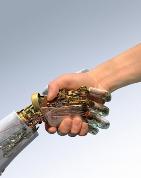The future of robotics investment
The International Federation of Robotics (IFR) points out that in excess of 150,000 new industrial robots were sold worldwide in 2011 – by far the highest number of sales recorded in a single year. Electronics manufacturers are among the leaders in the robotics field. Last year Panasonic and Foxconn unveiled plans to replace an undetermined number of human workers with one million robots to cut labour costs.
Robot investment opportunities in 2012?
A screening by Saxo Bank revealed that US stock markets have far and away the greatest exposure to the information technology sector, followed closely by Japan, Sweden and Germany. But even in these advanced economies, opportunities to invest in robot companies are few and far between. “The obvious problem for investors is that there aren’t a lot of robot companies out there in the public market,” explained Mr Garnry. However, he does believe investors are about to see a tipping point. In Japan, Panasonic has managed to utilise robots so effectively that one of its factories is capable of producing two million TV sets per month with just 15 employees.
IFR data also reveals a substantial upturn in robotics investment over the last few years. Robot shipments to the US more than doubled in 2010 compared to 2009, increasing to 14,380. Some 14,000 industrial robots were also shipped to Germany, 65 per cent more than in 2009. Overall, the global stock of operational industrial robots is expected to increase to 1.3 million by the end of 2014. This is based on IFR’s annual forecasted growth rate of around six per cent per year.
“Your opportunity in the public market is not that big in robots, but it will probably be bigger as we move forwards in time,” notes Mr Garnry. “We need more robot technology to get productivity up in our part of the world. We think it will be a major trend over the next two or three decades.”
What sectors have embraced robotics?
Military robotics is one of the most active areas, although opportunities for investors to seize on start-up potential are scarce. Aerospace giants tend to dominate the marketplace, absorbing start-ups. Government funding for military research projects also tends towards larger established conglomerates, while countries like the US pump money into projects through organisations such as Nasa and the Department of Defense.
The healthcare sector offers substantial opportunities for the expansion of robotics. Mr Garnry believes robotics has the potential to address the rising cost of healthcare in developed economies. Autonomous medical robotics developer Aethon raised $7.1 million in funding to support the expansion of its technology platform across new global markets. One of the unique selling points for the healthcare industry is efficiency, such as equipment and supplies transportation.
“I think robot technology will become more and more interconnected with the problems we have there, so you can have remote healthcare monitoring, predictive algorithms that can diagnose disease early on,” explained Mr Garnry.
What’s the future for robot technology investment?
Commercial robotics is expected to become far more widespread over the coming decades. There is also plenty of speculation about the potential for greater consumer market penetration too, especially following the success of advanced technologies such as Microsoft’s Kinect device for video games console Xbox 360. For robotics, the Kinect’s global success proved a blessing in disguise, helping to reduce the cost of visual systems used in other devices. However, investors should be aware that robotics remains a risky investment precisely because it is still emerging.
There is also an emerging venture capital appetite for robotics, underlined by Amazon’s purchase of robotics manufacturing firm Kiva. This is reassuring, because it may encourage other pure robotics companies and start-ups to float themselves on the markets. The benefits of robotics investment are clear for companies such as Amazon, for which efficiently run warehouses are a fundamental part of the business.
Investors can get limited exposure to robotics through Boeing and John Deere, which are both companies involved in the field. However, robotics only make up a fraction of their operating profits. Stocks in firms such as iRobot or KUKA will offer a significantly higher exposure, according to Frank Tobe, editor and publisher of The Robot Report. He also suggested that investments in pharmaceutical technology or in industrial robot manufacturers could be potential avenues for investors.
So while opportunities may seem scant for investors at the moment, there is a clear sense that the fledgling robotics industry is on the brink of emerging into something even more exciting. As Peter Garnry says: “We are just seeing the beginnings of what will be something really huge and we will look back at 2010 to 2015 as the period where we saw the tipping point in robotics and it just exploded.”

